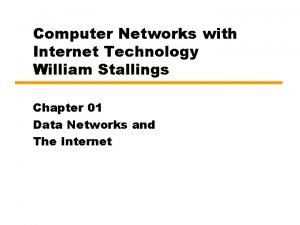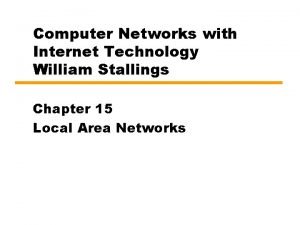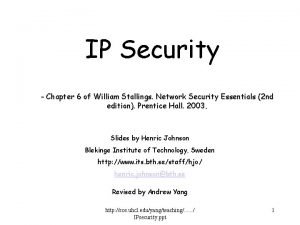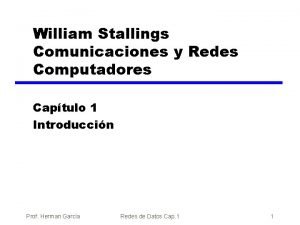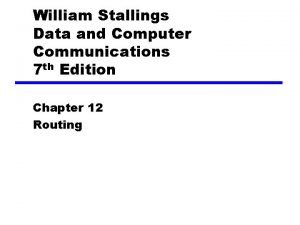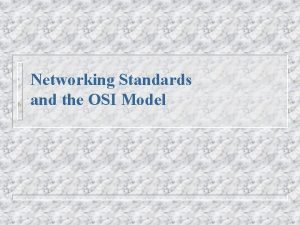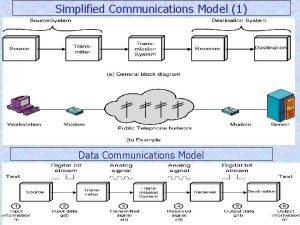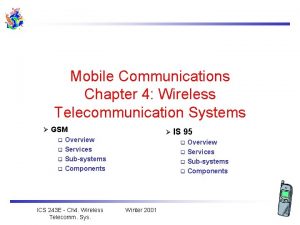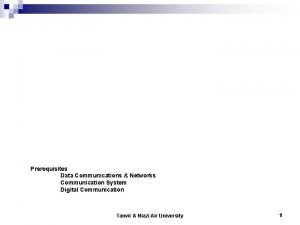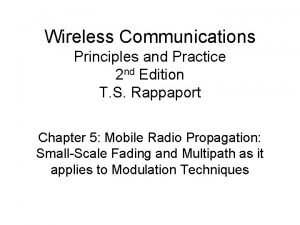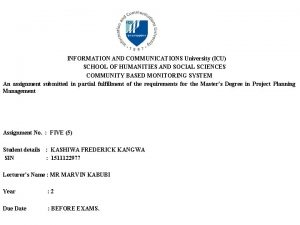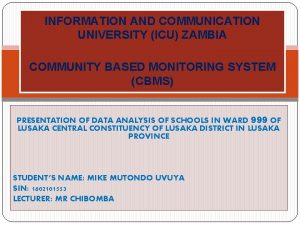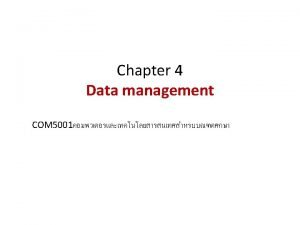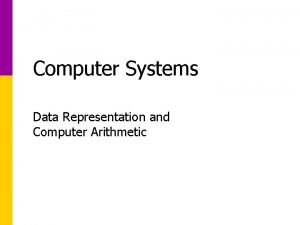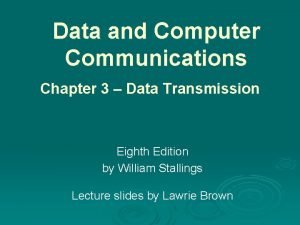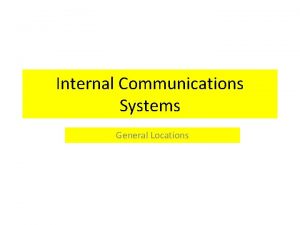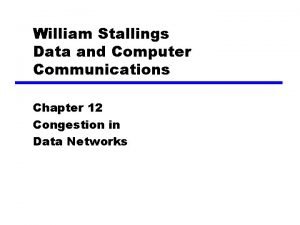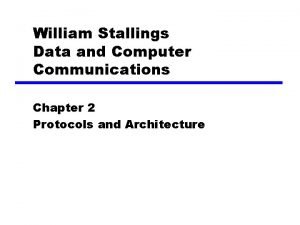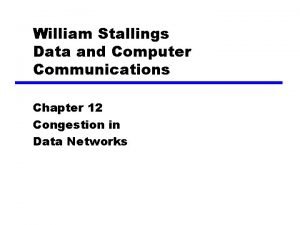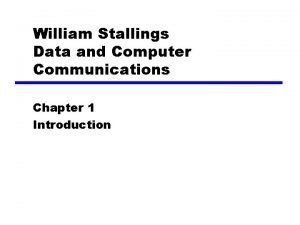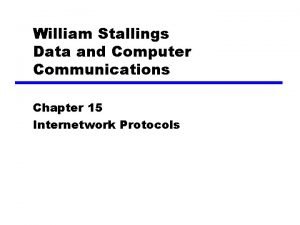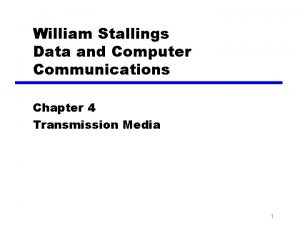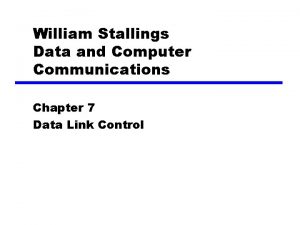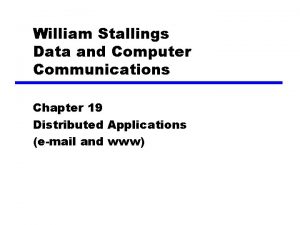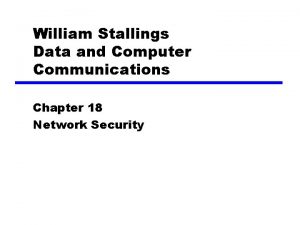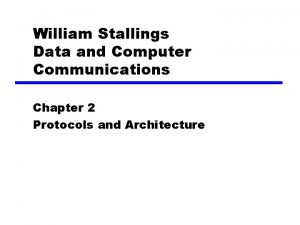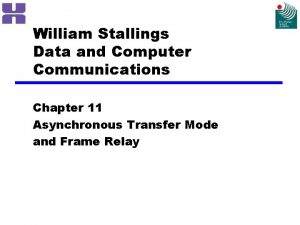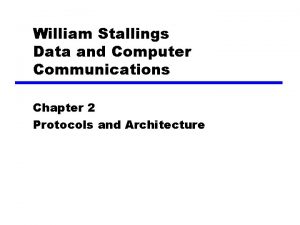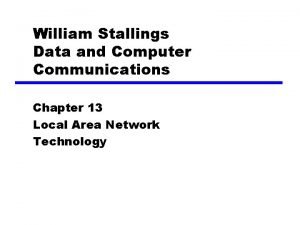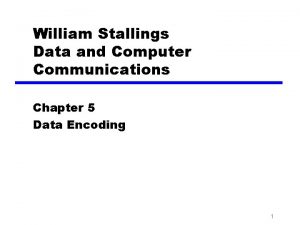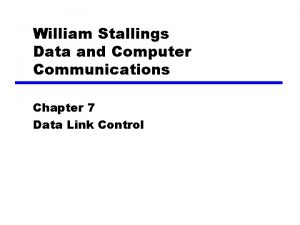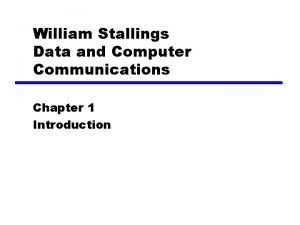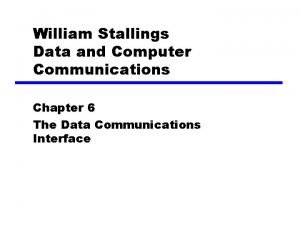William Stallings Data and Computer Communications Chapter 13













































































- Slides: 77

William Stallings Data and Computer Communications Chapter 13 區域網路技術(Local Area Network Technology) 1

區域網路應用(LAN Applications) (1) z 個人電腦(Personal computer) LANs y低成本(Low cost) y有限的資料率(Limited data rate) z 後端網路(Back end networks)及儲存區網路 (storage area networks) y連接大型系統(Interconnecting large systems),如 mainframes 及大型儲存裝置(large storage devices) x高資料率(High data rate) x高速介面(High speed interface) x分散式存取(Distributed access) x有限距離(Limited distance) x有限數目的設備(Limited number of devices) 2

區域網路應用(LAN Applications) (2) z 高速辦公室網路(High speed office networks) y桌上影像處理(Desktop image processing) y高容量區域儲存體(High capacity local storage) z 主幹區域網路(Backbone LANs) y連結(Interconnect)低速本地區域網路 y可靠性(Reliability) y容量(Capacity) y成本(Cost) 3

LAN 架構(Architecture) z 協定架構(Protocol architecture) z 圖形結構(Topologies) z 介質存取控制(Media access control) z 邏輯連結控制(Logical Link Control) 4

協定架構(Protocol Architecture) z OSI模型較低的幾層(Lower layers of OSI model) z IEEE 802 參考模型(reference model) z 實體層(Physical) z 邏輯連結層(Logical link control) (LLC) z 介質存取控制層(Media access control) (MAC) 5

IEEE 802 v OSI 6

802 層次(Layers) – 實體 (Physical)層 z 訊號的編碼(Encoding)/解碼(decoding) z Preamble 產生(generation)/去除(removal) z 位元(Bit) 傳輸(transmission)/接收(reception) z 傳輸介質(Transmission medium)及圖形結構 (topology) 7

802 層次(Layers) - 邏輯連結控制 (Logical Link Control)層 z 至較高階層介面(Interface to higher levels) z 流量與錯誤控制(Flow and error control) 8

802 層次(Layers) – 介質存取控制 (Media Access Control)層 z 將資料組裝(assembly)上位址(address)及錯誤偵 測欄位(error detection fields)成為訊框(frame) z 解裝訊框(Disassembly of frame) y辨認位址(Address recognition) y錯誤偵測(Error detection) z 掌管(Govern)傳輸介質的存取(access) y傳統的第二層資料連結控制並無此作業 z 對於同一個LLC, 有若干個MAC 選擇可用 (available) 9

IEEE標準 10

LAN 協定之關係(Protocols in Context) 11

圖形結構(Topologies) z 樹狀(Tree) z 直線式(Bus) y樹的特例(Special case of tree) x一條主幹線,無分支(One trunk, no branches) z 環狀(Ring) z 星狀(Star) 12

LAN圖形結構(Topologies) 13

直線(匯流排)式(Bus)與樹狀(Tree) z 多點式(Multipoint)介質(medium) z 傳輸遞移過整個(propagates throughout)介質 z 被其上所有的設備所接收(Heard by all stations) y 需識別目標設備(Need to identify target station) x每部設備有唯一的位址(unique address) z 設備與接頭(tap)間為全雙 作業(Full duplex connection) y 允許資料可被送上介質及由介質上接收 z 須調節傳輸(regulate transmission) y 以避免碰撞(avoid collisions) y 以避免(avoid hogging) x資料以小區段(small blocks) – 訊框(frames)為單位來傳送 z 在介質兩端的終端器(Terminator)會吸收訊框(absorbs frames),並將其由介質上移除 14

訊框傳輸(Frame Transmission) – 直線式區域網路(Bus LAN) 15


訊框傳輸(Frame Transmission) 環狀(Ring) LAN 17


介質存取控制 (Media Access Control) z 何處(Where) y集中式(Central) x可提供更大的存取控制能力(Greater control) x每一設備只需使用相當簡單的存取邏輯(access logic) x避免同等設備之分散協調(co-ordination)的問題 x單一位置的失效會造成整個網路癱瘓(Single point of failure) x可能會形成瓶頸(Potential bottleneck)而造成效能降低 y分散式(Distributed) z 方式(How) y同步(Synchronous) x專屬的通訊能力會指定給一條連線(Specific capacity dedicated to connection) y非同步(Asynchronous) x反應立即之需求(In response to demand) 19


MAC 訊框格式 (Frame Format) z MAC層由LLC層收到資料區塊 z 訊框中的欄位有: y. MAC 控制(control) y目標MAC位址(Destination MAC address) y來源MAC位址(Source MAC address) y來自LLC層之PDU y循環冗餘檢查(CRC) z MAC層負責偵錯(detects errors)及拋棄(discards) 任何錯誤的訊框(frames) z LLC層則選擇性地(optionally)記錄已被成功接收 的訊框,並重傳(retransmits)不成功之訊框 (unsuccessful frames) 21


LLC 服務(LLC Services) z 建立在HDLC的基礎上(Based on HDLC) z 不具認可訊號之非連線式服務(Unacknowledged connectionless service) z 連接模式服務(Connection mode service) z 具有認可訊號之非連線式服務(Acknowledged connectionless service) 23

LLC協定(LLC Protocol) z 建立在HDLC模型之上(Modeled after HDLC) z 使用HDLC之非同步平衡作業模式(Asynchronous balanced mode)以支援連線模式(connection mode)之LLC服務(第二型作業方式,type 2 operation) z 使用未編號之資訊PDU(Unnumbered information PDUs)來支援具有認可訊號之非連線式服務 (Acknowledged connectionless service) (第一型, type 1) z 利用LLC服務存取點(LLC service access point, LSAP)來提供多 處理(Multiplexing)的能力 24

典型的訊框格式(Typical Frame Format) 25


傳輸介質(Transmission Media) z 雙絞線(Twisted pair) y不適用於較高資料率的共享匯流排(shared bus) z 基頻同軸電纜 (Baseband coaxial cable) y用於乙太網路(Ethernet) z 寬頻同軸電纜 (Broadband coaxial cable) y原本包含於 802. 3規格書中,但無後續規劃 z 光纖(Optical fiber) y昂貴(Expensive) y可用性困難(Difficulty with availability) y不被使用(Not used) z 安裝新網路很少用此方式(Few new installations) y被星狀式雙絞線或光纖所取代 27

基頻同軸電纜 (Baseband Coaxial Cable) z 使用數位訊號處理(digital signaling) z 編碼方式可以是Manchester或是差分式 Manchester z 電纜的整個頻譜(frequency spectrum)均被用到 z 電纜上只有單一通道(single channel) z 送入的訊號均會往兩個方向傳遞(Bi-directional) z 最多只能傳送數公里遠(Few kilometer range) z Ethernet (802. 3標準的基本架構)作業速率為 10 Mbps z 50 歐姆(ohm)的電纜 28


10 Base 2 z 較便宜(Cheapernet) z 0. 25英吋電纜 y較具彈性(More flexible) y較適合 作站(Easier to bring to workstation) y較省電(Cheaper electronics) y較易受干擾(Greater attenuation) y容易受雜訊影響(Lower noise resistance) y較少接頭數(Fewer taps) (30) y較短距離(Shorter distance) (185 m) 30

再生器(Repeaters) z 往兩方向傳送(Transmits in both directions) z 銜接(Joins)兩段(segments)電纜 z 不需暫存資料(No buffering) z 段落間無邏輯上之分隔(No logical isolation of segments) z 若兩部位於不同段落的設備同時送出封包,則會 發生踫撞(collide) z 為了避免多重路徑之干擾情形的發生,任何兩部 設備之間只能存在有一條路徑(Only one path of segments and repeaters between any two stations) 31

基頻組態(Baseband Configuration) 32


環狀再生器狀態(Ring Repeater States) 34




環狀介質(Ring Media) z 雙絞線(Twisted pair) z 基頻同軸電纜(Baseband coaxial) z 光纖(Fiber optic) z 不適合用寬頻同軸電纜(Not broadband coaxial) y因為再生器可能必須能以非同步方式來收發多條通道 上的資料(Would have to receive and transmit on multiple channels, asynchronously) 38


克服時序變異限制(Solving Timing Jitter Limitations) z 再生器使用鎖相迴路(phase locked loop) y使位元時間之偏離量達到最小(Minimize deviation from one bit to the next) z 在數個再生器中使用緩衝器(buffer) y保存一固定數目之位元(Hold a certain number of bits) y加以擴展或是縮減以保持環狀系統之位元長度固定 (Expand contract to keep bit length of ring constant) z 可藉以大幅增加環狀系統的大小(Significant increase in maximum ring size) 40

可能的環狀問題(Potential Ring Problems) z 任何一條連線(Break in any link)或是再生器失效 (repeater failure),均會造成整個網路癱瘓 (disables network) z 安裝一供新設備使用的再生器必須先認明圖形結 構上相鄰兩個再生器的身分(identification of two topologically adjacent repeaters) z 時序變異(Timing jitter)的問題 z 須有一些移除循環封包(removing circulating packets)的方法 y及備份(backup)的技術以處理錯誤(errors)的情形 z 大多可用星環狀架構(star-ring architecture)克服 41


星狀(Star) LANs z 使用未遮蔽雙絞線(unshielded twisted pair wire)(電話) y 最低安裝成本(Minimal installation cost) x可能已有安裝(May already be an installed base) x建物中現有的佈線已涵蓋所有辦公室 z 連結(Attach)到一中央主動式集線器(central active hub) z 兩對雙絞線(Two links) y 一條傳送(transmit)一條接收(receive) z 集線器(Hub)將進來的訊號(incoming signal)複製(repeats) 到所有輸出線路上(on all outgoing lines) z 連線長度(Link lengths)限制在約100公尺 y 若是光纖(Fiber optic) – 可達到 500公尺 z 邏輯上仍是一直線式系統(Logical bus)–會發生踫撞 (collisions) 43

二階層星狀圖形架構(Two Level Star Topology) 44


交換式集線器(Switched Hubs) z 不須改變設備之軟硬體(No change to software or hardware of devices) z 每部設備(device)有專屬的(dedicated)傳輸能力(capacity) z 擴充性佳(Scales well) z 儲存並轉送式交換機(Store and forward switch) y 接收輸入、暫存、然後輸出 z 穿透式交換機(Cut through switch) y 利用訊框前頭(the start of the frame)的目標位址(destination address) y 一旦辨認(recognize)出位址開始將進來的訊框轉送(repeating)至 輸出線路上 y 可能遞送某些壞訊框(May propagate some bad frames) 46

集線器(Hubs) 與 交換機(Switches) 47

無線區域網路(Wireless LANs) z 機動性(Mobility) z 彈性(Flexibility) z 不易佈線的區域(Hard to wire areas) z 無線系統減少的成本(Reduced cost of wireless systems) z 無線系統增加的效能(Improved performance of wireless systems) 48

無線區域網路應用(Wireless LAN Applications) z 區域網路的擴展(LAN Extension) z 不同建築物間之連線(Cross building interconnection) z 漫遊式存取(Nomadic access) z 特殊用途之網路(Ad hoc networks) 49

LAN的擴展(Extension) z 具廣大開放性空間之建築物(Buildings with large open areas) y製造業 廠(Manufacturing plants) y倉庫(Warehouses) z 老式建築物(Historical buildings) z 小辦公室(Small offices) z 可能與有線系統混合使用(May be mixed with fixed wiring system) 50

單胞式無線區域網路(Single Cell Wireless LAN) 51

多胞式無線區域網路(Multi Cell Wireless LAN) 52

不同建築物間之連線 (Cross Building Interconnection) z 建物之間會使用一點對點之無線式連線(Point to point wireless link between buildings) z 其所連接的設備一般為橋接器或是路由器 (Typically connecting bridges or routers) z 用在無法使用纜線之處(Used where cable connection not possible) y如跨越街道(across a street) 53

漫遊式存取 (Nomadic Access) z 機動的資料終端設備(Mobile data terminal) y如膝上型電腦(laptop) z 提供從laptop到伺服器(server)的資料傳輸 z 校園(Campus)或群聚的建築物(cluster of buildings) 54

特殊用途之網路 (Ad Hoc Networking) z 同等設備間之相連(Peer to peer) z 臨時性的(Temporary) z 如會議(conference) 55

無線區域網路組態(Wireless LAN Configurations) 56

無線LAN之需求(Wireless LAN Requirements) z 輸出率(Throughput) z 節點數目(Number of nodes) z 與主幹LAN的連線能力(Connection to backbone) z 服務範圍(Service area) z 電池功率消耗(Battery power consumption) z 傳輸的穩固性與保密性(Transmission robustness and security) z 搭配式網路作業(Collocated network operation) z 免執照作業(License free operation) z 交遞(Handoff)/漫遊(roaming) z 動態組態(Dynamic configuration) 57

無線區域網路技術(Wireless LAN Technology) z 紅外線式(Infrared, IR) LANs z 展頻式(Spread spectrum) LANs z 窄頻帶之微波(Narrow band microwave) 58

橋接器 (Bridges) z 擴展超越單一LAN的能力(Ability to expand beyond single LAN) z 提供連接(interconnect)至其他LAN/WAN的方式 z 使用橋接器(bridge)或路由器(router) z 橋接器較簡單(Bridge is simpler) y連接類似的區域網路(Connects similar LANs) y實體層(physical)與連結層(link layers)是用相同的協定 (Identical protocols) y最少的處理(Minimal processing) z 路由器適用性較廣(more general purpose) y可連結(Interconnect)不同種類的LANs及WANs y參考後續說明 59

為何用橋接器(Why Bridge)? z 可靠度(Reliability) z 效能(Performance) z 安全性(Security) z 地理因素(Geography) 60

橋接器功能(Functions of a Bridge) z 讀取在一LAN上傳送的所有訊框,並接收目標為 送給另一LAN上設備的訊框(accept those address to any station on the other LAN) z 使用後者LAN之MAC 協定,將這些訊框轉傳至該 LAN上(Using MAC protocol for second LAN, retransmit each frame) z 相反方向的傳輸作業也是以此方式完成(Do the same the other way round) 61

橋接作業(Bridge Operation) 62

設計橋接器時需注意的地方(Bridge Design Aspects) z 不會修改訊框的格式(format)或內容(content) z 不會再加上其他的標頭(No encapsulation) z 只是照著位元地(bitwise)拷貝(copy)訊框 z 應具有足夠的緩衝空間,以滿足尖峰需求(Minimal buffering to meet peak demand) z 必須具有定址(address)與路由(routing)的智慧 y 須能知道要讓哪些訊框通過(pass) y 可能會跨越多個橋接器(more than one bridge to cross) z 一部橋接器可能連接兩個以上的LANs z 設備不會感覺有橋接作業(Bridging is transparent to stations) y 讓多個LAN上的設備彷彿在單一LAN一般相互通訊(Appears to all stations on multiple LANs as if they are on one single LAN) 63

橋接器協定架構 (Bridge Protocol Architecture) z IEEE 802. 1 D z MAC 階層(level) y設備位址(Station address)在此階層 z 橋接器不需LLC層(layer) y其是中繼(relaying) MAC 訊框(frames) z 可以將訊框穿越(pass)過外界的通訊系統(over external comms system) y如 WAN 連線(link) y擷取訊框(Capture frame) y加上標頭(Encapsulate it) y透過連線轉傳(Forward it across link) y去除標頭(Remove encapsulation)並轉傳至區域網路連 64 線上(forward over LAN link)

兩個區域網路的連接(Connection of Two LANs) 65


多個區域網路(Multiple LANs) 67

擴展樹(Spanning Tree) z 橋接器會自動(automatically)建立(develops)一路 由表格(routing table) z 依圖形結構的變化而自動更新 z 訊框前送(Frame forwarding) z 位址學習(Address learning) z 迴路解決(Loop resolution) 68



擴展樹演算法(Spanning Tree Algorithm) z 位址學習(Address learning)適用於(works for)樹 狀結構(tree layout) y亦即:無封閉迴圈(no closed loops) z 對任何一個相連的圖形結構(connected graph), 存在一擴展樹(spanning tree)既能維持相連性 (connectivity )且不含封閉迴圈 z 每部橋接器被賦予(assigned)一唯一的識別號碼 (unique identifier) z 任兩部橋接器互相交換識別號碼以建立一擴展樹 (Exchange between bridges to establish spanning tree) 71

橋接器的迴圈(Loop of Bridges) 72

Required Reading z Stallings chapter 13 z Loads of info on the Web 73

網路卡安裝 z http: //www. linpus. com. tw/docdir/faq/peripheral /nic. htm 74

Internet Sharing z Two-NIC Internet Sharing z Single NIC Internet Sharing 75

Two-NIC Internet Sharing 76

Single NIC Internet Sharing 77
 William stallings data and computer communications
William stallings data and computer communications Computer organization and architecture william stallings
Computer organization and architecture william stallings William stallings computer networks
William stallings computer networks William stallings computer networks
William stallings computer networks Network security essentials 5th edition pdf
Network security essentials 5th edition pdf Kr
Kr William stallings
William stallings William stallings
William stallings Stallings william comunicaciones y redes de computadores
Stallings william comunicaciones y redes de computadores Cryptography william stallings
Cryptography william stallings Data and computer communications 10th edition
Data and computer communications 10th edition Data and computer communications
Data and computer communications Data and computer communications
Data and computer communications Garbage collection stallings
Garbage collection stallings Stallings garbage pickup
Stallings garbage pickup Ovid metamorphoses daphne and apollo
Ovid metamorphoses daphne and apollo Metodo stallings
Metodo stallings Lh stallings
Lh stallings Means of telecommunication
Means of telecommunication Backbone network components
Backbone network components Business data communications and networking
Business data communications and networking Introduction to data communications and networking
Introduction to data communications and networking Business data communications and networking
Business data communications and networking Network communication models
Network communication models Chapter 4 communications and documentation quiz
Chapter 4 communications and documentation quiz Chapter 3 network protocols and communications
Chapter 3 network protocols and communications Simplified communications model
Simplified communications model Introduction to data communications
Introduction to data communications Chapter 4 fire service communications
Chapter 4 fire service communications Communications chapter
Communications chapter Define components of computer
Define components of computer Difference between a computer and computer system
Difference between a computer and computer system Output devices drawing
Output devices drawing Computer architecture and computer organization difference
Computer architecture and computer organization difference Track and report nims
Track and report nims Tactical communications
Tactical communications Global marketing and communications
Global marketing and communications Designing and managing marketing communications
Designing and managing marketing communications Digital communications and networks
Digital communications and networks K state communications and marketing
K state communications and marketing Business communications process and product
Business communications process and product Business communications process and product
Business communications process and product What is acars system
What is acars system Designing and managing integrated marketing communications
Designing and managing integrated marketing communications Monitor communications process tools and techniques
Monitor communications process tools and techniques Attitudes and persuasive communications
Attitudes and persuasive communications Advertising and marketing communications
Advertising and marketing communications Atc communications and radio procedures
Atc communications and radio procedures Amplified expressiveness
Amplified expressiveness Sircim
Sircim Information and communications university
Information and communications university Integrating communications assessment and tactics
Integrating communications assessment and tactics Information and communication university
Information and communication university Designing and managing integrated marketing channels
Designing and managing integrated marketing channels Designing and managing integrated marketing communications
Designing and managing integrated marketing communications What is the difference between data and information
What is the difference between data and information Data representation and computer arithmetic
Data representation and computer arithmetic Where a computer keeps data instructions and information
Where a computer keeps data instructions and information Data and computer communication
Data and computer communication Basic structure of computer system
Basic structure of computer system Complete computer description in computer organization
Complete computer description in computer organization Design of basic computer with flowchart
Design of basic computer with flowchart Tomorrow and tomorrow creeps
Tomorrow and tomorrow creeps Crisis communication working group
Crisis communication working group Teledrop
Teledrop 113-com-1022 perform voice communications
113-com-1022 perform voice communications Performing voice communications army
Performing voice communications army Communication mix
Communication mix Oracle communications services gatekeeper
Oracle communications services gatekeeper Unified communications open source
Unified communications open source Open platform communications unified architecture
Open platform communications unified architecture Who are puma unified communications
Who are puma unified communications Bioinformatics toolbox matlab
Bioinformatics toolbox matlab The product of a sender's encoding is the
The product of a sender's encoding is the Objectives of marketing communication
Objectives of marketing communication Push pull profile strategies marketing communications
Push pull profile strategies marketing communications Utility communications market analysis
Utility communications market analysis Internal communications system
Internal communications system


